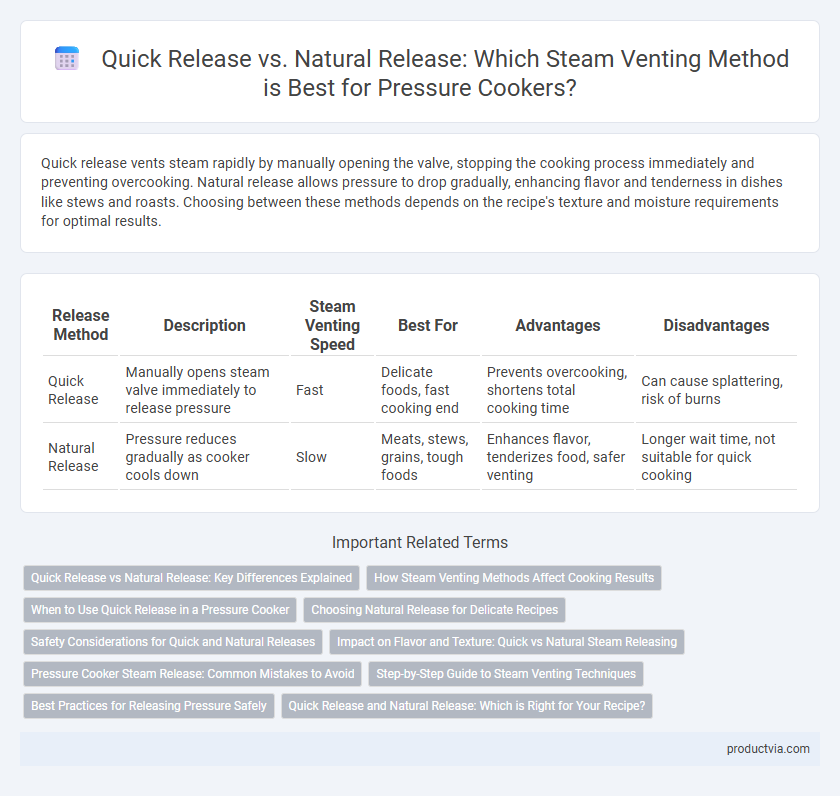Quick release vents steam rapidly by manually opening the valve, stopping the cooking process immediately and preventing overcooking. Natural release allows pressure to drop gradually, enhancing flavor and tenderness in dishes like stews and roasts. Choosing between these methods depends on the recipe's texture and moisture requirements for optimal results.
Table of Comparison
| Release Method | Description | Steam Venting Speed | Best For | Advantages | Disadvantages |
|---|---|---|---|---|---|
| Quick Release | Manually opens steam valve immediately to release pressure | Fast | Delicate foods, fast cooking end | Prevents overcooking, shortens total cooking time | Can cause splattering, risk of burns |
| Natural Release | Pressure reduces gradually as cooker cools down | Slow | Meats, stews, grains, tough foods | Enhances flavor, tenderizes food, safer venting | Longer wait time, not suitable for quick cooking |
Quick Release vs Natural Release: Key Differences Explained
Quick release vents steam rapidly by manually opening the pressure valve, reducing cooking time and preventing overcooking, ideal for vegetables and delicate foods. Natural release allows pressure to drop gradually as the pot cools, preserving texture and flavor, especially suitable for meats and stews. Choosing between quick release and natural release depends on the recipe's moisture needs and desired tenderness.
How Steam Venting Methods Affect Cooking Results
Quick release venting rapidly expels steam, preventing overcooking and preserving texture in delicate foods like vegetables and seafood. Natural release allows pressure to decrease gradually, enabling tougher cuts of meat or beans to continue cooking gently, enhancing tenderness and flavor absorption. Choosing the correct steam venting method directly impacts moisture retention, texture, and overall dish quality in pressure cooking.
When to Use Quick Release in a Pressure Cooker
Quick release is ideal for cooking delicate foods like vegetables and seafood that require minimal residual heat to avoid overcooking. This method rapidly vents steam, preventing further cooking once pressure is reached and preserving texture and nutrients. Use quick release when precise cooking times and texture retention are crucial.
Choosing Natural Release for Delicate Recipes
Natural release method gently reduces pressure inside a pressure cooker, preserving the texture and moisture of delicate foods like fish, poultry, and custards. This slow venting process prevents overcooking and maintains the structural integrity of ingredients, ensuring tender, flavorful results. For recipes requiring precise cooking, natural release minimizes the risk of food breaking apart compared to quick release, which rapidly releases steam and can disrupt fragile dishes.
Safety Considerations for Quick and Natural Releases
Quick release allows rapid steam venting to prevent overcooking but requires caution to avoid burns from the sudden, high-pressure steam discharge. Natural release gradually reduces pressure, minimizing the risk of hot steam bursts and ensuring safer handling, especially for dense or liquid-rich foods. Choosing the appropriate release method enhances overall pressure cooker safety by balancing cooking requirements with controlled steam evaporation.
Impact on Flavor and Texture: Quick vs Natural Steam Releasing
Quick release rapidly vents steam, preserving the texture of delicate ingredients by preventing overcooking but can sometimes result in less infused flavors due to abrupt pressure change. Natural release allows gradual steam venting, enhancing flavor development and tenderizing tough cuts by maintaining consistent pressure during cooking. Choosing between the two methods depends on the desired balance between flavor depth and texture precision in pressure cooking.
Pressure Cooker Steam Release: Common Mistakes to Avoid
When steam venting a pressure cooker, avoid the common mistake of quickly releasing steam without considering food type, as rapid pressure release can cause splattering or undercooked meals. Natural release allows pressure to drop gradually, preventing liquid from boiling over and preserving texture, especially for dense or starchy dishes. Always follow manufacturer guidelines to ensure safe and effective steam venting, minimizing risks of burns or damage to the cooker.
Step-by-Step Guide to Steam Venting Techniques
Quick release involves turning the pressure valve to vent steam immediately, rapidly lowering pressure inside the cooker within seconds, ideal for delicate foods that require precise timing. Natural release lets the pressure decrease slowly on its own as the cooker cools, retaining moisture and intensifying flavors, best suited for dense or tough meats needing extended cooking. Following a step-by-step guide ensures safety: for quick release, use a utensil to turn the valve to avoid burns; for natural release, leave the valve untouched until pressure indicator drops.
Best Practices for Releasing Pressure Safely
When using a pressure cooker, the quick release method rapidly vents steam by turning the valve to release pressure immediately, ideal for delicate foods that require precise cooking times. Natural release allows the pressure to drop gradually as the cooker cools, preventing splatters and preserving moisture, making it best for dense or starchy dishes. Following manufacturer guidelines, using oven mitts, and keeping hands away from steam vents are essential best practices to release pressure safely and avoid burns.
Quick Release and Natural Release: Which is Right for Your Recipe?
Quick release rapidly vents steam from the pressure cooker, making it ideal for delicate vegetables and seafood that require minimal cooking time to preserve texture and nutrients. Natural release gradually reduces pressure, allowing tougher cuts of meat and dishes with layered flavors to tenderize slowly, enhancing taste and juiciness. Choosing between quick release and natural release depends on the recipe's ingredient type and desired texture, optimizing both cooking efficiency and final dish quality.
Quick release vs Natural release for steam venting Infographic

 productvia.com
productvia.com